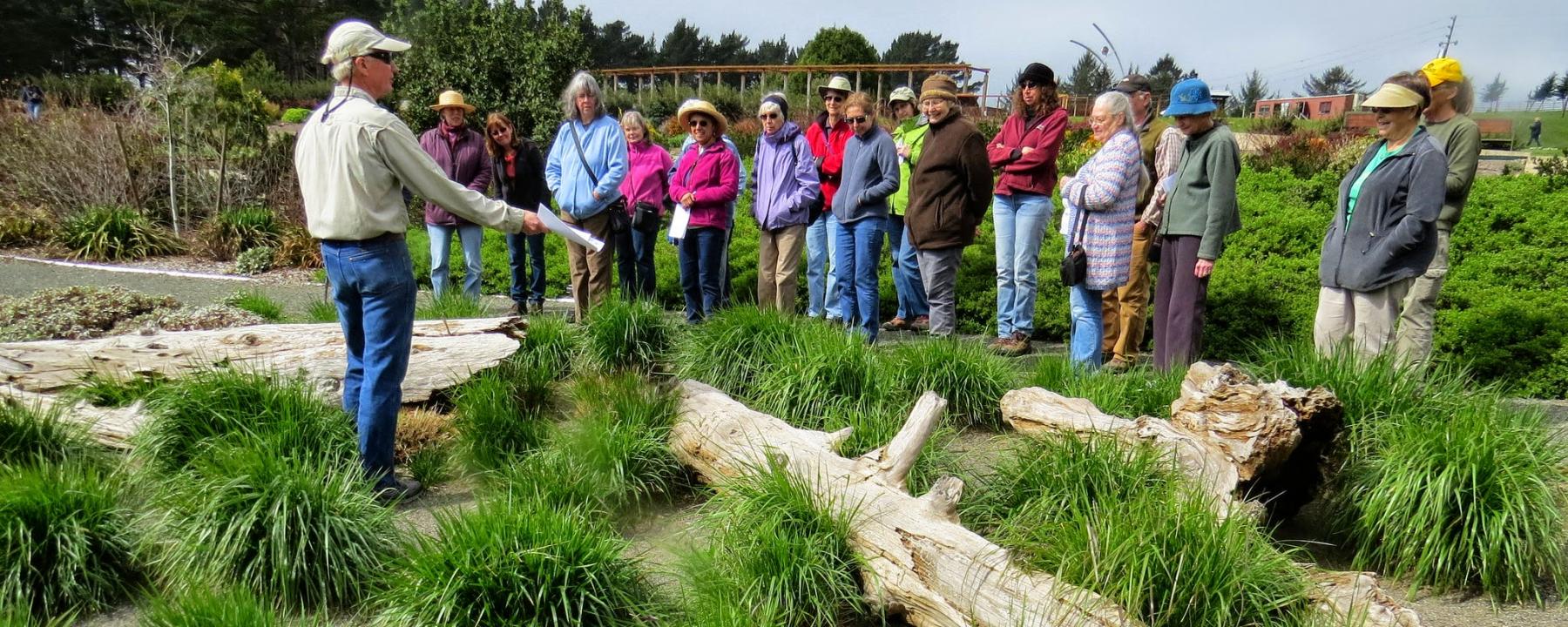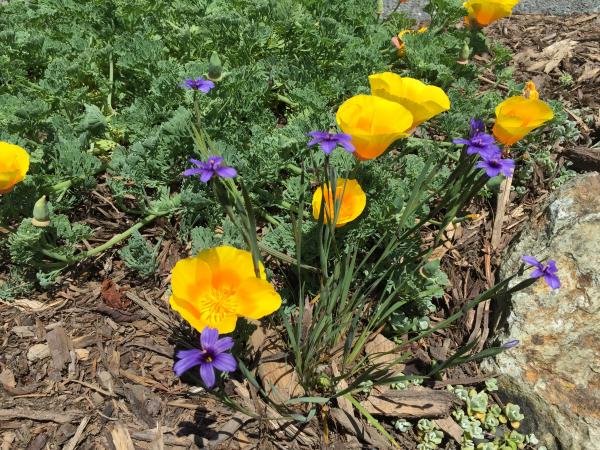
I urge all you native plant lovers to take a walk through the Lost Coast Brewery Native Plant Garden (NPG) this spring as it begins to put out new foliage and bloom! Expanding the interest and diversity of this garden has become a passion and commitment of mine over the past five years since becoming its volunteer curator. The NPG was first planted in 2007-2008, and since then has been steadily growing in stature and complexity. We now have over 120 California native species or cultivated selections represented in the 24 separate garden beds covering approximately 1.5 acres.
 Although not yet in full bloom, (can you say “stop raining!”) many plants begin flowering in the NPG at this time of year. Look for the first coastal California poppy (Eschscholzia californica var. maritima), Douglas’ meadowfoam (Limnanthes douglasii), bush monkeyflower (Mimulus aurantiacus), Siskiyou checkerbloom (Sidalcea malviflora ssp. patula), Idaho blue eyed grass (Sisyrinchium idahoense), and seaside wooly sunflower (Eriophyllum staechadifolium). These and several others should start to bloom at this time, although I expect delays for many given the cold, wet weather they have been enduring for the past six months.
Although not yet in full bloom, (can you say “stop raining!”) many plants begin flowering in the NPG at this time of year. Look for the first coastal California poppy (Eschscholzia californica var. maritima), Douglas’ meadowfoam (Limnanthes douglasii), bush monkeyflower (Mimulus aurantiacus), Siskiyou checkerbloom (Sidalcea malviflora ssp. patula), Idaho blue eyed grass (Sisyrinchium idahoense), and seaside wooly sunflower (Eriophyllum staechadifolium). These and several others should start to bloom at this time, although I expect delays for many given the cold, wet weather they have been enduring for the past six months.
Later this spring and summer the large white “fried egg” flowers of Matilija poppy (Romneya coulteri), and the bright yellows of California Fremontia (Fremontodendron californicum) will appear. Also visible will be the pale blue daisy-like flowers of California aster (Aster chilensis), the red tubular flowers of two forms of California fuchsia (Epilobium canum), and the pink blooming heads of dune buckwheat (Eriogonum latifolium).
On the west side of the native plant garden, look now for the low, pinkish-white blooming mounds of Fort Bragg manzanita (Arctostaphylos nummularia), along with the yellow flowered Oregon grape (Berberis aquifolium). Near the top of the NPG, and below the Paver Pavilion you may see the beautiful blue blooms of two of our California lilacs (Ceanothus thrysiflorus ‘Skylark’) and (Ceanothus papillosus var. roweanus x griseus ‘Joyce Coulter’). You will notice the ‘Skylark’ ceanothus is smaller, since we replaced all 40 older, declining plants this year with vigorous new ones.
I am committed to the continued improvements to the NPG by filling in the last of the unplanted areas (not much space left!), adding new and interesting natives from the California Floristic Province, replacing poorly performing specimens, and adding more structure and interest. In the last three years alone we have introduced over 500 new plants, including species such as giant buckwheat (Eriogonum giganteum), ‘Select Mattole’ California fuchsia (Epilobium septentrionale ‘Select Mattole’), bush anemone (Carpenteria californica), and four specimens of the extremely rare Franciscan manzanita (Arctostaphylos franciscana). The latter species will be the subject of a fascinating future blog entry!
Finally, we obtained about 20 large landscape rocks from the Trinity River this winter courtesy of Mercer Fraser Company and Humboldt Fish Action Council. Keep an eye out for these new elements to be placed in the NPG this spring as well! Because the native plant garden changes dramatically throughout the seasons, I invite you to return often to enjoy the beauty and progression of growth, flowering, and diversity of plant textures.
---Mark Moore, Volunteer Curator, LCBNPG
